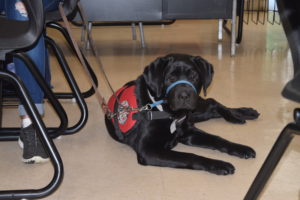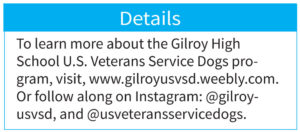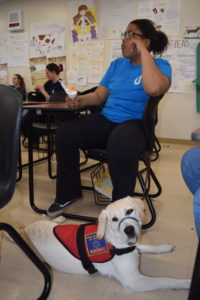Nonprofit profile: FFA is raising puppies to change vets’ lives
Gilroy High’s FFA Service Dog program teaches responsibility
Click HERE to read stories published in the May 29 – June 11, 2019 issue of Gilroy Life
 A high school campus is a place for acquiring new skills, making new friends, understanding how to socialize, and learning to help others. At Gilroy High School, those endeavors aren’t just limited to humans. They’re also shared by a group of four-legged, tail-wagging friends who will eventually make an impact on U.S. servicemen and women.
A high school campus is a place for acquiring new skills, making new friends, understanding how to socialize, and learning to help others. At Gilroy High School, those endeavors aren’t just limited to humans. They’re also shared by a group of four-legged, tail-wagging friends who will eventually make an impact on U.S. servicemen and women.
Elida Moore is a Future Farmers of America advisor at Gilroy High School, where she teaches Agricultural Biology, Agricultural Science I, Veterinary Science, and Agricultural Government/Economics. She oversees the school’s U.S. Veterans Service Dogs program, which includes her dog, Odette, as well as Berto, Cleopatra (Cleo), Colt, Charlotte, and Delilah. It doesn’t hurt that Moore is as full of energy as the puppies who go through her program.
“Before this, I got started through a friend with Guide Dogs for the Blind,” Moore recalled. “Then last summer, I was introduced to the USVSD program. They need a lot of raisers, and Cody Bellanger (USVSD founder, CEO, and director of training and client services) was so excited that we wanted to start a program.”
 Moore was eager to make it happen. After speaking to Gilroy High’s principal, Marco Sanchez, Moore started meeting with interested students. She assured everyone that they’d be held to an extremely high standard.
Moore was eager to make it happen. After speaking to Gilroy High’s principal, Marco Sanchez, Moore started meeting with interested students. She assured everyone that they’d be held to an extremely high standard.
“Raisers must maintain a 3.0 GPA,” Moore explained. “They understand there will be distractions, and they sign a contract. But they dive into it wholeheartedly. They’re so excited to be out there every day.”
The dogs go through a variety of training in order to aid veterans who may be physically disabled, experiencing mobility issues, or living with post-traumatic stress disorder. According to USVSD, they are “dedicated to helping veterans return to a new ‘normal’ by training and placing quality service dogs with veterans.”
 It’s quite an undertaking, but well worth the time and effort, as well as the occasional frustration. After all, puppies are babies and don’t always do what they’re told. But service dogs change the lives of those they serve, often enabling them to rejoin society and do things they thought they’d never do again.
It’s quite an undertaking, but well worth the time and effort, as well as the occasional frustration. After all, puppies are babies and don’t always do what they’re told. But service dogs change the lives of those they serve, often enabling them to rejoin society and do things they thought they’d never do again.
For those with PTSD, their symptoms may not be visible, but their effects can be overwhelming. A sense of hypervigilance, sensitivity to startling noises, and other factors can spark irritability, anxiety, and panic, with sometimes unpredictable consequences.
“They’re starting task training so they can become PTSD dogs,” Moore said.
Think of a weighted blanket, and how therapists recommend it to help instill a feeling of security. The dogs serve the same purpose.
“They’re learning to apply light and deep pressure therapy,” Moore continued. “They can lie on top of someone with PTSD, or get on their lap, until they can regain composure and be calm. For anxiety, the dogs apply light pressure.”
Similarly, the dogs are learning how to slowly navigate surroundings such as a supermarket and locate an exit. For those who need assistance with mobility, the dogs learn to pick up dropped items, tug to open doors, hold and carry things, and brace their veteran partner to prevent falls and maintain balance.
Just like the real world, a high school campus is full of distractions. There are lunch bags and backpacks to sniff, lush green lawns to roll on, and noisy, giggle-filled conversations in crowded hallways. It’s hard enough for students to stay focused on any given day, let alone a puppy. But that’s the point.
“These dogs must learn to deal with distractions and keep focused,” Moore said. “They learn what’s called a ‘down stay,’ meaning they don’t move until they’re released. It’s our important job to bring up the confidence in these dogs.”
Moore’s USVSD group plans regular outings to locations such as the Monterey Bay Aquarium and San Francisco, as well as a BART ride, to ensure that their canines are comfortable in a variety of situations. Therefore, it’s also critical that the students commit to following through on their dogs’ learning.
But according to Moore, that’s not been a huge concern so far. “The kids are super dedicated,” she said. “They monitor themselves and learn a lot more than responsibility.” The students fill out monthly reports to track the dogs’ progress and identify challenges. The program has had an overwhelmingly positive response, from students and faculty alike. By now, everyone knows that once the dog is “vested,” that is, dressed in their vest, they’re working and need to focus.
In January, the dogs will finish their training with USVSD in Louisiana and be partnered with a veteran. But before then, the student raisers give them an excellent foundation. And in many ways, the student learns just as much as their canine companion.
Chelsi Faria, another Gilroy High teacher, has three dogs in her floral design class. She observed, “One of my favorite things in the program is that kids don’t realize how much work it is to have someone else depend on them, to feed and care for the animals.”
There are occasions when raisers can’t be with their dogs. Maybe they have a medical appointment or need to take an important test. For those times there’s a team of “sitters” available, approved by Moore, who can take over and continuing a puppy’s training in their raiser’s absence.
Faria is one of those sitters. Andrew Plaza, 17, a senior at Gilroy High School, is another. “I work with Cleo almost daily,” he said. “We do behavioral training, and task training. She’s very well-behaved and smart. She picks things up fast.”
As a sitter, Plaza rotates between Cleo, Berto, and Odette almost every day. He’s looking forward to pursuing a career in veterinary science and is taking veterinary classes. He understands how much work it takes to raise these puppies and train them to serve those who’ve served. Echoing Faria’s words, Plaza said, “It’s more responsibility. I’m not just caring for myself. I have to do both my schoolwork and take care of the dog.”
It’s time well spent. A military veteran will soon depend on a dog they train to assist with daily tasks. Thanks to the USVSD program at Gilroy High, that’s a small sacrifice in exchange for a powerful act of service.
